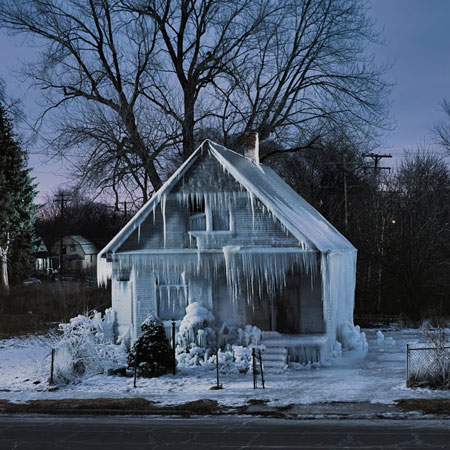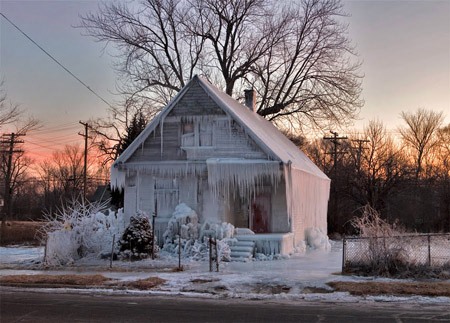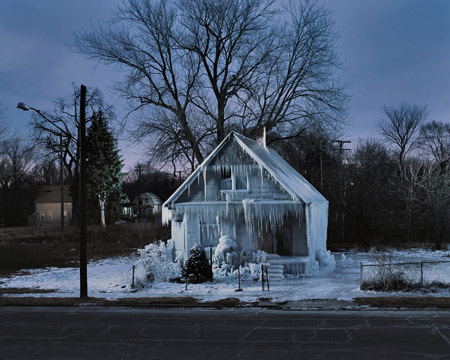
Ice House Detroit by Gregory Holm and Matthew Radune
Ice House Detroit is an abandoned suburban home in Detroit covered in ice by photographer Gregory Holm and architect Matthew Radune.

The installation highlights issues of housing foreclosures and abandoned neighbourhoods in the city in the wake of the credit crunch.

Here's some text from Holm and Radune:
---
Gregory Holm, a photographer, and Matthew Radune, an architect, are collaborating on this winter of 2009-2010 architectural installation. The project, which involves working with several Detroit organizations, aims to uphold concepts of neighborhood integrity, material reuse, public art, social empowerment, and urban farming. With the current freeze in the housing market, Detroit is leading the nation in foreclosures.
Ice House Detroit references this contemporary urban condition, and involves the acquisition and recontextualization of one of the 80,000 abandoned houses in the city. The house will be sprayed with water in subzero temperatures, gradually building up layers of ice over the course of several days or weeks. Once it is frozen, the common architectural and urban references of the house will be temporarily obscured, providing a period of reflection.
Aside from the installation itself, we will be producing fine art prints, a limited edition art book, and a film which will document the transformation of the house and potentially the legal and bureaucratic maneuvers necessary to pull off such an endeavor.
After completion of this project, we will be working with groups who will deconstruct this house, recycling the wood, metals, glass, and the cement foundation; keeping these materials from entering our dumps. Once the house is demolished, It is our intention to donate the property to local urban farmers for the cultivation of neighborhood vegetables.
To follow the progress of this project please view: The IceHouseDetroit Blog
Ice House Detroit is the first is the first in a series of large scale artworks conceived and produced by Gregory Holm and Matthew Radune. These artworks will exist as time-based architectural installations exploring the nature of contemporary culture. The primary artworks will serve as starting points from which explorations can be done in several media including photography and film.
About this project
Gregory Holm, a photographer, and Matthew Radune, an architect, are collaborating on this winter of 2009-2010 architectural installation. The project, which involves working with several Detroit organizations, aims to uphold concepts of neighborhood integrity, material reuse, public art, social empowerment, and urban farming.
With the current freeze in the housing market, Detroit is leading the nation in foreclosures.
Ice House Detroit references this contemporary urban condition, and involves the acquisition and recontextualization of one of the 80,000 abandoned houses in the city.
The house will be sprayed with water in subzero temperatures, gradually building up layers of ice over the course of several days or weeks. Once it is frozen, the common architectural and urban references of the house will be temporarily obscured, providing a period of reflection.
Aside from the installation itself, we will be producing fine art prints, a limited edition art book, and a film which will document the transformation of the house and potentially the legal and bureaucratic maneuvers necessary to pull off such an endeavor.
After completion of this project, we will be working with groups who will deconstruct this house, recycling the wood, metals, glass, and the cement foundation; keeping these materials from entering our dumps. Once the house is demolished, It is our intention to donate the property to local urban farmers for the cultivation of neighborhood vegetables.
To follow the progress of this project please view:
The IceHouseDetroit Blog
www.icehousedetroit.blogspot.com
Ice House Detroit is the first is the first in a series of large scale artworks conceived and produced by Gregory Holm and Matthew Radune. These artworks will exist as time-based architectural installations exploring the nature of contemporary culture. The primary artworks will serve as starting points from which explorations can be done in several media including photography and film.